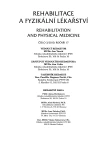Clinical Study of High-induction Electromagnetic Stimulator SALUS Talent
Authors:
J. Poděbradský; R. Poděbradská
Authors‘ workplace:
Lázně Dolní Lipová
Published in:
Rehabil. fyz. Lék., 17, 2010, No. 3, pp. 95-100.
Category:
Original Papers
Overview
This is a pilot study of clinical tests investigating analgesic effects of electromagnetic stimulator SALUS Talent on the pains in locomotor system. It is the first magneto-therapeutic device, where a subjective intensity can be reached during application of magnetic induction 2.5 Tesla. The statistical cohort enrolled 89 patients of rehabilitation outpatient department as well as patients undergoing therapy in Dolní Lipová Spa for dermal indications. The locomotor disorders were mostly of structural character. In most patients there was a marked, early and long-term analgesic effect. A dispersion effect proved to be dominant in this kind of treatment and it was direct as well as via sympathetic activation at the spinal stage, which subsequent improvement of thixotropic qualities of tissues in the application area.
Key words:
magnetotherapy, analgesia, analgesic effect, dispersion effect, SALUS Talent
Sources
1. CHVOJKA, J: Magnetoterapie v klinické praxi. Městec Králové: Nemocnice.
2. JEŘÁBEK, J.: Magnetoterapie. Nový Bydžov, 2EL s.r.o., 1993.
3. PODĚBRADSKÝ, J., PODĚBRADSKÁ, R.: Fyzikální terapie, manuál a algoritmy. Praha, Grada Publishing, 2009.
4. SALUS-TALENT: Clinical Application of Electro Magnetic Stimulatin. Korea Society of interventional Muscle and Soft Tissue Stimulation Therapy, 2010.
5. SALUS-TALENT: Návod k obsluze. Verze 1.00, CRTechnology, 2010.
Labels
Physiotherapist, university degree Rehabilitation Sports medicineArticle was published in
Rehabilitation & Physical Medicine

2010 Issue 3
Most read in this issue
- Tietze’s Syndrome Versus Multiple Myeloma
- Clinical Study of High-induction Electromagnetic Stimulator SALUS Talent
- Rehabilitation in Orofacial Region in Cases of Central Paresis of Facial Nerve
- Application of Electrotherapeutic Currents of the TENS Type in Physiotherapy
